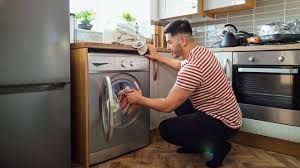Who to Call for Dryer Repair?
When your dryer stops working, it can disrupt your daily routine and laundry schedule. Knowing who to call for dryer repair can save you time, money, and frustration. In this comprehensive guide, we'll explore your options, from professional repair services to DIY solutions, ensuring your dryer is back in working order as quickly as possible.
Understanding Common Dryer Problems
Before diving into who to call for dryer repair, it's essential to understand common dryer issues. This knowledge will help you communicate effectively with repair professionals and potentially identify simple fixes you can handle yourself. Here are some frequent dryer problems:
- No Heat: If your dryer runs but doesn't produce heat, it could be due to a faulty heating element, thermostat, or thermal fuse.
- No Power: A dryer that won't turn on may have an electrical issue, such as a blown fuse, tripped circuit breaker, or a defective power cord.
- Drum Not Spinning: A broken belt, motor, or idler pulley can prevent the drum from spinning.
- Excessive Noise: Unusual noises may indicate problems with the drum support rollers, bearings, or drive belt.
- Overheating: An overheating dryer can be caused by a blocked vent, faulty thermostat, or a malfunctioning cycling thermostat.
- Clothes Not Drying Properly: If your clothes take too long to dry, it could be due to a clogged lint filter, blocked vent, or a failing heating element.
When to Call a Professional
While some dryer issues can be resolved with basic troubleshooting, others require the expertise of a professional. Here are some scenarios where calling a professional repair service is the best option:
1. Electrical Issues
If your dryer won't turn on or is experiencing electrical problems, it's crucial to call a licensed electrician or appliance repair technician. Working with electrical components can be dangerous and should only be handled by trained professionals.
2. Complex Mechanical Problems
Issues like a broken drum belt, faulty motor, or damaged bearings often require specialized tools and knowledge. A professional technician can accurately diagnose and fix these problems, ensuring your dryer operates smoothly.
3. Persistent Problems
If you've attempted DIY repairs without success or your dryer continues to malfunction, it's time to call a professional. Persistent issues may indicate underlying problems that require expert attention.
4. Warranty Considerations
If your dryer is still under warranty, attempting DIY repairs could void the warranty. Always check the warranty terms and contact the manufacturer or an authorized repair service to ensure your dryer remains covered.
Right Dryer Repair Service
When choosing a dryer repair service, it's essential to consider factors like experience, reputation, and cost. Here are some tips to help you find the right professional for the job:
1. Ask for Recommendations
Start by asking friends, family, or neighbors for recommendations. Personal referrals can provide valuable insights into the quality of service and customer satisfaction.
2. Check Online Reviews
Online reviews on platforms like Google, Yelp, and Angie's List can help you gauge the reputation of local repair services. Look for companies with consistently positive feedback and high ratings.
3. Verify Credentials
Ensure the repair service you choose is licensed, insured, and certified. This guarantees that the technicians have the necessary training and qualifications to handle your dryer repair safely and effectively.
4. Compare Quotes
Obtain quotes from multiple repair services to compare prices and services offered. Be wary of unusually low prices, as they may indicate subpar workmanship or hidden fees.
5. Inquire About Warranties
A reputable repair service should offer a warranty on their work. Ask about the warranty terms and duration to ensure you're covered if the problem reoccurs.
What You Can Fix Yourself
For those who enjoy tackling home repairs, some dryer issues can be resolved without professional help. Here are a few DIY fixes for common dryer problems:
1. Cleaning the Lint Filter and Vent
A clogged lint filter or vent can reduce your dryer's efficiency and pose a fire hazard. Regularly clean the lint filter after each use and inspect the vent for blockages. Use a vent cleaning kit to remove lint buildup from the vent hose and ducts.
2. Checking the Power Supply
If your dryer won't turn on, check the power supply. Ensure the dryer is plugged in and the circuit breaker hasn't tripped. Test the outlet with another appliance to confirm it's functioning correctly.
3. Replacing the Drum Belt
If the drum isn't spinning, the drum belt may be broken. Replacing the drum belt is a relatively simple task that requires basic tools and a replacement belt. Consult your dryer's manual for instructions on accessing and replacing the belt.
4. Testing and Replacing Fuses
A dryer that runs but doesn't heat may have a blown thermal fuse. Locate the thermal fuse (usually near the heating element) and test it with a multimeter. If the fuse is blown, replace it with a compatible part.
5. Inspecting the Door Switch
If your dryer won't start, the door switch may be faulty. Open the dryer door and press the switch manually. If the dryer starts, the switch may need replacement. Consult your dryer's manual for instructions on replacing the door switch.
Preventative Maintenance Tips
Regular maintenance can extend the life of your dryer and prevent common issues. Here are some preventative maintenance tips:
- Clean the Lint Filter
- Clean the lint filter after every load to maintain airflow and prevent lint buildup. A clogged lint filter can reduce drying efficiency and increase the risk of fire.
- Inspect and Clean the Vent
- Check the dryer vent regularly for blockages and clean it at least once a year. A clogged vent can cause overheating and reduce drying efficiency.
- Check the Drum Seal
- Inspect the drum seal for signs of wear or damage. A damaged seal can cause clothes to get stuck or torn during drying.
- Lubricate Moving Parts
- Lubricate the drum support rollers, idler pulley, and other moving parts to reduce friction and prevent excessive wear.
- Level the Dryer
- Ensure your dryer is level to prevent excessive vibration and noise. Adjust the feet as needed to achieve a stable, level position.
Efficient Dryer Repair
Knowing who to call for dryer repair can make a significant difference in the time and cost involved in getting your appliance back in working order. While some issues can be resolved with DIY solutions, others require the expertise of a professional repair service. By understanding common dryer problems, recognizing when to call a professional, and following preventative maintenance tips, you can keep your dryer running smoothly and efficiently. Whether you choose to tackle repairs yourself or hire a professional, the goal is to restore your dryer's functionality and get your laundry routine back on track.
You might also like
Educational Center
Book a Service Today
We will get back to you as soon as possible
Please try again later
Quick & Reliable
We are available 24/7
About Us
Authorized Appliance is an appliance repair contractor referral service. We connect you with appliance contractor in your area. All contractors are operated independently of Authorized Appliance. It is the responsibility of each user to verify that the contractor connected with meets all licensing and insurance requirements in that jurisdiction.
All Rights Reserved - Authorized Appliance




